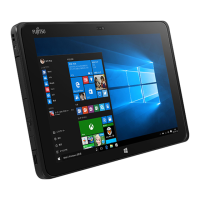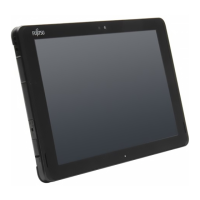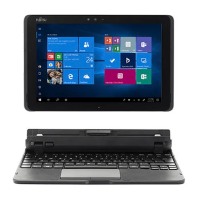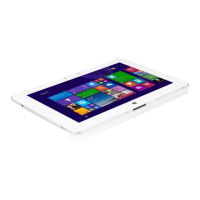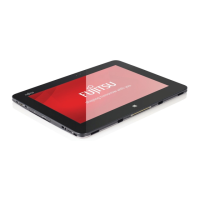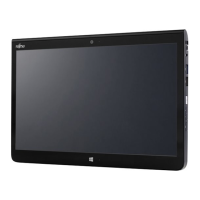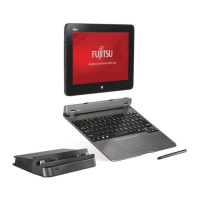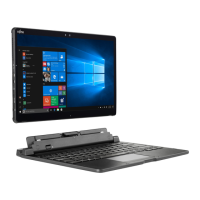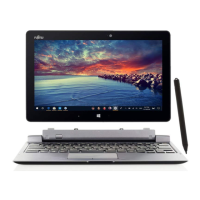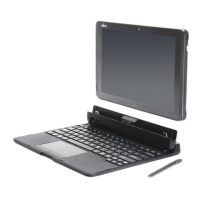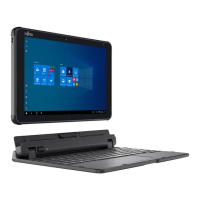
Do you have a question about the Fujitsu STYLISTIC Q5010 and is the answer not in the manual?
| HD type | WUXGA |
|---|---|
| Display diagonal | 10.1 \ |
| Touchscreen type | Capacitive |
| Anti-glare screen | Yes |
| Display brightness | 500 cd/m² |
| Display resolution | 1920 x 1200 pixels |
| Native aspect ratio | 16:9 |
| Processor cores | 4 |
| Processor family | Intel® Pentium® Silver |
| Processor frequency | 1.1 GHz |
| Processor manufacturer | Intel |
| Processor boost frequency | 3.1 GHz |
| Storage media | eMMC |
| Compatible memory cards | MicroSD (TransFlash), MicroSDHC, MicroSDXC, SD, SDHC, SDXC |
| Maximum memory card size | 512 GB |
| Internal storage capacity | 256 GB |
| Internal memory | 8 GB |
| Memory clock speed | 2400 MHz |
| Internal memory type | LPDDR4-SDRAM |
| Platform | Windows |
| 4G standard | LTE |
| Wi-Fi standards | 802.11a, 802.11b, 802.11g, Wi-Fi 4 (802.11n), Wi-Fi 5 (802.11ac) |
| Bluetooth version | 5.0 |
| Top Wi-Fi standard | Wi-Fi 5 (802.11ac) |
| Wi-Fi data rate (max) | 1733 Mbit/s |
| Mobile network generation | 4G |
| Audio system | Realtek ALC255 |
| Number of built-in speakers | 2 |
| Device type | Tablet PC |
| Form factor | Slate |
| Product color | Black |
| Protection features | Dust resistant, Water resistant |
| International Protection (IP) code | IP54 |
| Certification | MIL-STD-810H, WEEE, HCT / HCL entry / WHQL |
| Accelerometer | - |
| Password protection type | BIOS, HDD, Supervisor, User |
| Personal info management (PIM) | Alarm clock, Calculator, Calendar |
| HDMI ports quantity | 0 |
| USB 3.2 Gen 1 (3.1 Gen 1) Type-A ports quantity | 1 |
| Battery capacity | - mAh |
| Battery life (max) | 10 h |
| Rear camera type | Single camera |
| Rear camera resolution (numeric) | 8 MP |
| Front camera resolution (numeric) | 2 MP |
| Embedded options available | No |
| Depth | 168.9 mm |
|---|---|
| Width | 262.8 mm |
| Height | 12.4 mm |
| Weight | 605 g |
Highlights quick boot, long battery life, and BIOS security features for enhanced usability.
Directs users to online resources for drivers, software, and operating system support.
Explains the meaning of symbols, fonts, and formatting used to convey important information and warnings.
Identifies front-facing components like speakers, sensors, cameras, and docking ports.
Details ports on the left and right sides, including USB, SIM/memory card slots, and headphone jack.
Describes buttons like ON/OFF, volume, shortcut, microphone, and rear camera/fingerprint sensor.
Emphasizes essential safety information, including warnings and guidance for handling and cleaning the device.
Provides specific safety advice for using wireless features in critical environments like aircraft and hospitals.
Advises on protecting the display from damage like scratches and liquid exposure.
Outlines energy-saving features for conserving power and extending battery life.
Offers guidance on data backup, power adapter compatibility, and safe transport of the Tablet PC.
Provides instructions on safely cleaning the device, emphasizing gentle handling of the touchscreen.
Guides users on carefully unpacking and inspecting the device for any transportation damage.
Advises on choosing a safe and suitable environment for operating the Tablet PC, avoiding heat and soft surfaces.
Details the steps for connecting the mains adapter and power cable to the device for initial setup.
Explains the initial power-on process, software installation, and system test for first-time use.
Explains the meaning of power-on and battery charging indicators on the device.
Describes how to turn the Tablet PC on/off and program the ON/OFF button for efficient operation.
Covers touchscreen operation, pixel quality, and handwriting recognition features.
Provides instructions and guidelines for using the stylus pen, including proper handling and calibration.
Explains how to use the touchpad for navigation and the keyboard for input and special functions.
Describes the cradle's function for charging and connecting peripherals, including its components and connection steps.
Explains the keyboard dock's purpose for text input and Ethernet connection, and its connection process.
Guides on installing software for the fingerprint sensor to enable biometric authentication.
Explains how to set up BIOS passwords for enhanced system security and data protection.
Details how to activate and deactivate password prompts before the OS starts for boot security.
Explains how to enable and disable the TPM for enhanced hardware security features.
Guides on enabling the on-screen keyboard in BIOS for BitLocker password entry.
Instructions for connecting external displays via the Display port and VGA monitor port.
Explains connecting USB devices and the functionality of the USB Type-C port for charging and data.
Describes how to connect audio devices like headsets, headphones, and microphones to the combination port.
Provides steps to access and start the BIOS Setup Utility from the device.
Explains how to navigate and use the BIOS Setup Utility interface for configuration.
Details options for saving changes, discarding changes, loading defaults, and exiting the BIOS.
Outlines methods for resetting the device, including forced shutdown and battery reset.
Addresses issues like incorrect date/time, battery charging, dark touchscreen, and display readability.
Provides solutions for blank, unstable monitors and pen calibration or movement problems.
Offers troubleshooting for startup failures, system unresponsiveness, printer, and wireless connectivity issues.
Covers battery discharge, acoustic warnings, error messages, and restoring the system in Windows 10.
Lists detailed technical specifications for the Tablet PC, including processor, memory, display, and ports.
Provides ambient operating conditions and technical details for the rechargeable battery.
Lists specifications for the mains adapters, cradle, and keyboard dock for connectivity and power.
Offers guidance on the proper disposal and recycling of the Tablet PC's battery by authorized providers.
Mentions TCO certification, SAR limit value, and directs users to online resources for compliance details.
